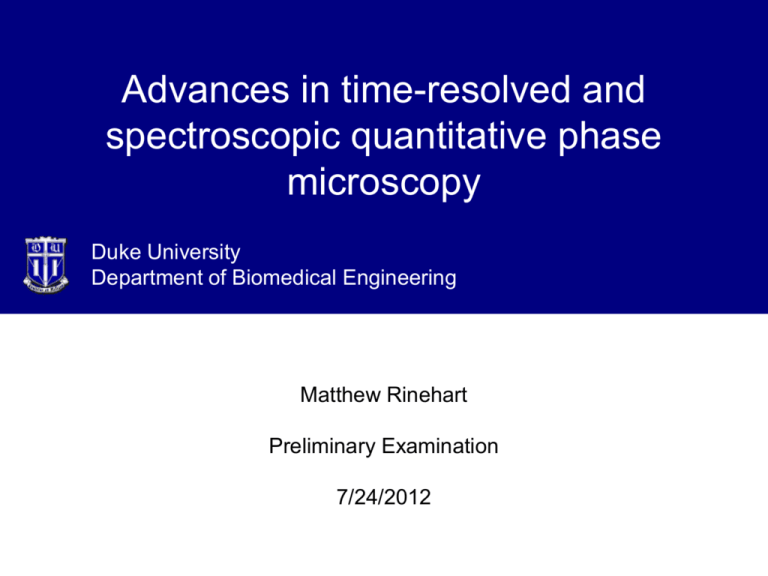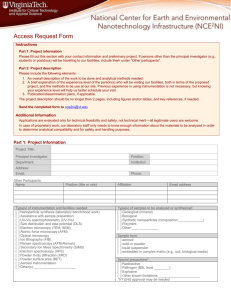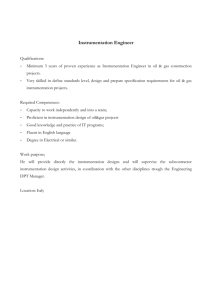
Advances in time-resolved and
spectroscopic quantitative phase
microscopy
Duke University
Duke
University, Fitzpatrick Institute for Photonics
Department
of Biomedical
Engineering
BIOS
Lab, Department
of Biomedical
Engineering
Matthew Rinehart
Preliminary Examination
7/24/2012
Outline
•
•
•
•
Summary of course work
Peer-reviewed publications
Motivation & introduction
Preliminary results
– QPM technology
– QPM applications
– QPS
• Research aims & timeline
Summary of course work
Term
Course
Course Title
Instructor
Fall 2008
PATH
225
Intro to Systemic Histology
L. Hale
2
BME 265
Advanced Optics
J. Kim
3
BME 233
Modern Diagnostic Imaging
Systems
J. MacFall
3
Imaging & Spectroscopy
D. Brady
Spring
2009
ECE 299
Units
3
PATH
250
General Pathology
L. Hale
4
ECE 299
Holography & Coherent Imaging
D. Brady
3
PHY 230
Math Methods in Physics
A. Kotwal
3
BME 265
Image Processing
S. Farsiu
3
BIO 154
Fundamentals of Neuroscience
S. Bilbo
3
Fall 2010
ECE 376
Lens Design
D. Brady
3
Spring
2011
ECE 399
Independent Study: Broadband
Diffraction Phase Microtomography
D. Brady
3
A. Wax
3
3
Fall 2009
Spring
2010
Fall 2011
BME 234 Modern Microscopy
Teaching Experience
Term
Spring
Fall
20122009
Fall 2010
BME 362
Course
BME 362
BME 171
Invention to Application
Course Title
Invention to Application
Intro to Signals & Systems
B. Myers
Instructor
B. Myers
J. Izatt
BME 171
Intro to Signals & Systems
J. Izatt
3
Requirements
Units
Advanced Math
3
Life Sciences
8
ECE Masters
Courses
12
Total:
42
RCR Hours
8 (of 12)
Publications
Peer-reviewed journal articles
1. S. Kim, M. T. Rinehart, H. Park, Y. Zhu, and A. Wax, “Spectrally multiplexed photothermal OCT and novel detection methods,"
Biomedical Optics Express (2012). In Review.
2. A. Wax, M. Giacomelli, T. E. Matthews, M. T. Rinehart, F. E. Robles, Y. Zhu, “Optical Spectroscopy of Biological Cells,”
Advances in Optics and Photonics, 2012. In Press.
3. M. T. Rinehart, Y. Zhu, and A. Wax, “Quantitative phase spectroscopy," Biomedical Optics Express 3, 958 (2012).
4. M. T. Rinehart, T. K. Drake, F. E. Robles, L. C. Rohan, D. Katz, and A. Wax, “Time-resolved imaging refractometry of
microbicidal films using quantitative phase microscopy," Journal of Biomedical Optics 16, 20510 (2011).
5. N. G. Terry, Y. Zhu, M. T. Rinehart, W. J. Brown, S. C. Gebhart, S. Bright, E. Carretta, C. G. Ziefle, M. Panjehpour, J. Galanko,
R. D. Madanick, E. S. Dellon, D. Trembath, A. Bennett, J. R. Goldblum, B. F. Overholt, J. T. Woosley, N. J. Shaheen, A. Wax,
“Detection of Dysplasia in Barrett's Esophagus With In Vivo Depth- Resolved Nuclear Morphology Measurements,”
Gastroenterology – 20 (2010)
6. M. T. Rinehart, N. T. Shaked, N. J. Jenness, R. L. Clark, and A. Wax, "Simultaneous two-wavelength transmission quantitative
phase microscopy with a color camera," Opt. Lett. 35, 2612-2614 (2010)
7. J. C. Booth, N. D. Orloff, J. Mateu, M. D. Janezic, M. T. Rinehart, and J. A. Beall, “Quantitative Permittivity Measurements of
Nanoliter Liquid Volumes in Microfluidic Channels to 40 GHz,” IEEE Transactions on Instrumentation and Measurement 99, 1-10
(2010)
8. N. T. Shaked, Y. Zhu, M. T. Rinehart, and A. Wax, “Two-step-only phase-shifting interferometry with optimized detector
bandwidth for microscopy of live cells,” Opt. Express 17, 15585-15591 (2009)
9. N. T. Shaked, M. T. Rinehart, and A. Wax, "Dual-interference-channel quantitative-phase microscopy of live cell dynamics," Opt.
Lett. 34, 767-769 (2009)
Book Chapters
1.
2.
Yizheng Zhu, Matthew T. Rinehart, Francisco E. Robles, and Adam Wax, “Polarization and Spectral Interferometric
Techniques for Quantitative Phase Microscopy,” in Biomedical Optical Phase Microscopy and Nanoscopy, Shaked (Editor),
Elsevier, 2012. In press.
N. T. Shaked L. L. Satterwhite, M. T. Rinehart, and A. Wax, "Quantitative Analysis of Biological Cells Using Digital Holographic
Microscopy," in Holography, Research and Technologies, Rosen (Editor), Intech, 2011.
Publications
+14 conference abstracts/presentations
(incl. SPIE)
+2 additional non-reviewed pubs
Motivation
• Semitransparent objects are hard to image
• While methods exist to produce high-contrast images of
some of these objects, these methods are not well-suited
for quantitative analysis
• Advanced holographic imaging techniques have been
developed for quantitative imaging of this class of
samples, but have not yet become useful to
biology/clinical researchers
Motivation: Develop techniques and instruments aimed at
making QPM more accessible to laboratories as a research
tool for investigating biological samples
Quantitative phase microscopy
Δϕ
• Phase microscopy measures
relative optical path delays,
proportional to refractive index
mismatch
∆𝜙 ∗ 𝜆
∆𝑂𝑃𝐿 =
=
2𝜋
𝑛𝑖 𝑑𝑖
𝑖
• Interferometrically measuring
optical phase delays can yield
quantitative information
• Optimal for nearly transparent
samples that lack inherent
contrast
• Resulting data can be both
visualized in quasi-3D and also
used for quantitative analysis
QPM for biological samples
•
QPM has been developed to study quantitative
changes in in vitro cell cultures
•
Morphological parameters used by cell biologists
are based on cell thickness rather than phase
profile
–
•
How to decouple refractive index from thickness
using
phase homogeneous
profiles?
1. Assume
refractive index
2.
•
E.g. – cell volume, cell force distribution
Make differential measurements using multiple
wavelengths or varying-RI media
These methods have limited use for dynamically
changing cells with organelles with non-uniform
refractive index
QPM for biological samples
Δ𝜑 𝑥, 𝑦, 𝜆, 𝑡 𝜆
∆𝑂𝑃𝐿(𝑥, 𝑦, 𝜆, 𝑡) = ∆𝑛 𝑥, 𝑦, 𝜆, 𝑡 𝑑 𝑥, 𝑦, 𝑡 =
2𝜋
•
QPM has been developed to quantitatively
investigate morphological structures and dynamic
changes in in vitro cell cultures
–
Cell volume
–
Cell force distribution
–
Organelle location
•
Previous work has relied on quantitative analysis
of temporal and spatial fluctuations
•
Relatively little attention has been focused on
quantitative spectral measurements
–
Material dispersion properties
–
Absorption effects via complex refractive index
9
Specific Aims
1) Optimize QPM for analysis of biological
systems
2) Apply QPM to biologically-relevant systems
3) Extend QPM to quantitative phase
spectroscopy (QPS)
4) Advanced implementations and applications of
QPM & QPS
Specific Aims
Develop QPM
instrumentation
& techniques
Develop QPS
instrumentation
& techniques
Apply QPM to
dynamic systems
Develop QPS for
molecular
specificity
Specific Aims
Develop QPM
instrumentation
& techniques
Develop QPS
instrumentation
& techniques
Apply QPM to
dynamic systems
Apply QPS for
molecular
specificity
QPM Instrumentation
Microscope configuration
• Microscopic samples delay light
• 4F configuration images wavefront onto
camera
• Samples are relatively thin
QPM Instrumentation
reference field & interference
• matched wavefronts via matched objectives
𝐼 = 𝐸𝑆 + 𝐸𝑅
2
= 𝐸𝑆 2 + 𝐸𝑅 2 + 2𝐸𝑆 𝐸𝑅 cos 𝜑𝑆 − 𝜑𝑅
𝜑𝑆 − 𝜑𝑅 = 𝑞𝑥 + 𝜑𝑂𝐵𝐽𝐸𝐶𝑇
14
On-axis phase shifting vs. off-axis
Phase-shifting interferometry: can
require mechanical shifting
𝐼 = 𝐸𝑆 + 𝐸𝑅
Dynamic Interferometry, Neal Brock, James C. Wyant,
et al. Proceedings of SPIE Vol. 5875 (SPIE,
Bellingham, WA), page 58750F-1, 2005
2
= 𝐸𝑆 2 + 𝐸𝑅 2 + 2𝐸𝑆 𝐸𝑅 cos
𝜑𝑆 − 𝜑𝑅 = 𝑞𝑥 + 𝜑𝑂𝐵𝐽𝐸𝐶𝑇
QPM: Off-axis Theory
=atan2
{
Phase, RI, thickness, wavelength
Δ𝜑 𝑥, 𝑦, 𝜆, 𝑡 𝜆
∆𝑂𝑃𝐿(𝑥, 𝑦, 𝜆, 𝑡) = ∆𝑛 𝑥, 𝑦, 𝜆, 𝑡 𝑑 𝑥, 𝑦, 𝑡 =
2𝜋
QPM spatial frequency
comparisons
Natan T. Shaked, Yizheng Zhu, Matthew T. Rinehart, and Adam Wax
Optics Express, Vol. 17, Issue 18, pp. 15585-15591 (2009)
Result 1: Dynamic SOFFI
N.T. Shaked, M.T. Rinehart, and A.
Wax, "Dual-interference-channel
quantitative-phase microscopy of
live cell dynamics," Opt. Lett. 34,
767-769 (2009)
Phase Unwrapping
Phase Unwrapping
2π Rollover, 2λ Unwrapping
absolute measured m 2
•
m=?
•
2π rollover can be removed using
unwrapping algorithms
–
Iterative gradient-minimization algorithms
•
Sharp changes in phase cannot be
accurately resolved
•
Imaging at 2 wavelengths extends
measurement range
12
1 2
633nm & 532nm 3.33μm
12
Subtract wrapped phase maps &
add 2π where <0
12 1 2 2 (1 2 ) 0
•
Amplifies phase noise ΟPD 1212
2π
Use beat wavelength phase map
as guide to add correct
multiple of 2π
2λ Phase Unwrapping Result
Phase Referencing
Phase Referencing
Phase unwrapping & RI
mapping
• Inhomogeneity of films can cause
spatial variation in phase much
greater than π
• Use of temporal + spatial phase
unwrapping together to ensure
– Assumes that the phase does not
change by more than π between
time points
Phase Reference for RI
mapping
• Need a tool for full decoupling of
refractive index from height in thick
samples
• We have designed a PDMS ramp to
provide an absolute refractive index
• The ramp is positioned on the edge of
the field of view
film
FOV
Calculating RI from phase
Δ𝑛1,2 𝜆 ∙ 𝑑 = 𝑛1 𝜆 − 𝑛2 𝜆
Δ𝜑1,2 𝜆 ∙ 𝜆
𝑛1 𝜆 =
+ 𝑛2 𝜆
2𝜋 ∙ 𝑑
Δ𝜑1,2 𝜆 ∙ 𝜆
∙𝑑 =
2𝜋
10μm
2
1
Calculate relative index changes:
• Object thickness, 𝑑
Calculate absolute refractive index
• Object thickness, 𝑑
• Known reference material with well-characterized
𝑛
26
Conclusions & next steps
Conclusions
Develop QPM
instrumentation
& techniques
Next Steps
Build turnkey device that is robust
and user-friendly
• Standardized sample loading
• Basic software that enables
simple image processing
Examined tradeoff between on-axis & offaxis in phase microscopy
Developed balanced approach with
simultaneous acquisition
Developed single-shot 2-wavelength
QPM instrumentation & method with color
camera
Came up with system for calibrating a
chamber for absolute imaging
refractometry
Specific Aims
Develop QPM
instrumentation
& techniques
Develop QPS
instrumentation
& techniques
Apply QPM to
dynamic systems
Apply QPS for
molecular
specificity
Microbicidal films
Films as a drug delivery vehicle
Parameters of interest
•
•
•
•
•
•
•
•
•
•
•
•
portable
easy to store
discreet
low cost
require no applicator
stored in solid form, can chemically
stabilize drugs over long periods of
time
swelling index
bioadhesion properties
moisture content
disintegration time
dissolution & drug release
drug content uniformity
(AP Photo/Keith Srakocic)
Current method of evaluation
Franz cells are used to measure membrane /
tissue permeability. Bulk parameters are
calculated, but the model assumes
homogeneity
© 2006 All Rights Reserved, Conrex Pharmaceuticals Corp.
Quantitative phase microscopy can be
used to study microbicidal film dissolution
dynamics with high temporal and spatial
resolution
Preliminary Dissolution Results
• Bolus injection of water in gel
Film imaging geometry
Microbicidal films
characteristics:
• Loaded with active agent CSIC
• 80-100μm thick
Experimental Parameters
•
10x magnification
•
~500x700um FOV
•
Flood chamber with water
“instantaneously”
•
Acquire images every 0.5-1s as
film dissolves
• 4-10 minute disintegration time
• Refractive index = 1.44
• Films are highly
inhomogeneous
• Common ingredients: of EDTA,
PVA, Carbopol 974, cholesterol,
ethanol, BHA, glycerin, active
Microbicidal film refractive index
Refractive
Index
1.355
1.344
1.334
Assumes one area in FOV is always a known RI (here, water)
Calibrated film refractometry
• Calibration ramp structure
allows absolute RI
calculation of the chamber
• Combination spatial +
temporal phase unwrapping
allows film RI to be
determined even during
initial hydration chaotic
changes
Quantitative analysis of dissolution
Experiment considerations
• Only a small area of the film is within the field of view
• The film area is flooded from the side at t=0
– Doesn’t necessarily match biophysical hydration of films
• Model assumes homogeneous film RI
• Data is 2D RI map; 3D mapping would be ideal
Conclusions & next steps
Conclusion
QPM Refractometry of films offers a
quantitative tool for measuring
dissolution characteristics
• RI
• % hydration, water
• Total disintegration time
Apply QPM to
dynamic systems
Next Steps
Develop quantitative summary metrics &
standardized method for comparing
dissolution across different films
• Thickness
• Composition
Develop methods of measuring active
agent / particle / molecule release from
films
• Fluorescence
• Absorptivitiy
• Raman
Specific Aims
Develop QPM
instrumentation
& techniques
Develop QPS
instrumentation
& techniques
Apply QPM to
dynamic systems
Apply QPS for
molecular
specificity
Why Spectroscopy?
• Digitally adjust coherence properties of sample
illumination
– Improve noise characteristics
– Synthesize coherence windows to gain depth sensitivity
• Measure sample dispersion
• Molecular identification based on KramersKronig relation (concentration-dependent RI
phenomena)
Quantitative phase spectroscopy
Quantitative
phase
microscopy
Rapidly-tunable
laser source
Quantitative
phase
spectroscopy
39
QPS outline
• Techological Advances
– Illumination temporal sweep
– Low coherence illumination
• Results
– Coherent noise reduction
– RI Spectroscopy of absorptive features
– Refractometry for concentration measurement
Spectral Sweep of Fianium+AOTF
41
QPS: low-coherence illumination
Low-coherence illumination effects
43
QPS
Spectroscopic imaging results
• Speckle reduction via averaging
• Dispersion measurements of discrete
fluorophore objects
• Bulk measurements of homogeneous fluid
samples
45
Coherent noise reduction
10μm
• Transmission
phase target
custom-molded
with PDMS
• 90nm nominal
thickness
• Average phase
images acquired
across the
spectrum
σ(Δφ)
σ(ΔOPL)
38.2 mrad 1.09
11.8
3.55 nm
46
Microsphere dispersion measurements
polystyrene
+
fluorophore
polystyrene
48
Bulk hemoglobin RI measurements
PDMS
Δφ
Δn
PDMS
σ = 0.00029
331 g/L
165 g/L
10 μm
110 g/L
DiH2O
Oxyhemoglobin
(HbO2)
55 g/L
H2O
49
Conclusions & next steps
Instrumentation Advances
• Illumination temporal sweep
• Low coherence illumination
Develop QPS
instrumentation
& techniques
Techniques Demonstrated
• Coherent noise reduction
Next Steps
• RI Spectroscopy of absorptive
features
• Improve spectral
illumination characteristics
• Refractometry for concentration • Add trinocular display
measurement
Specific Aims
Develop QPM
instrumentation
& techniques
Develop QPS
instrumentation
& techniques
Apply QPM to
dynamic systems
Develop QPS for
molecular
specificity
Proposed Work
Develop QPM
instrumentation &
techniques
Develop QPS
instrumentation &
techniques
• Improve Illumination
• Build InCh Microscope
• Add binocular
display
Apply QPM to dynamic
systems
• Develop robust & standardized
assay for film dissolution
Develop QPS for molecular
specificity
• Use ratiometric imaging &
photothermal
• Image microbicidal films & RBCs
with molecular specificity
InCh microscope
•
Current microscopy of blood smears search for morphology & parasites
•
Requires staining & trained microscopist reading slides
•
NOT high throughput
•
Suffers from interobserver variability
InCh microscope would be a
robust platform for automated
image acquisition & analysis
NSF I-Corps program:
assess commercial viability,
connect the correct value
proposition to the customer needs
Microbicidal films
Only a small area of the film is
within the field of view
The film area is flooded from the
side at t=0
•
Develop quantitative summary
(AP Photo/Keith Srakocic)
metrics
& standardized method for
comparing dissolution across
different films
•
•
•
Thickness
Composition
Conduct study of dissolution
across multiple films to validate
utility of method
Doesn’t necessarily match
biophysical hydration of films
Model assumes homogeneous
film RI
Data is 2D RI map; 3D mapping
would be ideal
QPS Instrumentation Advances
• Narrower-band illumination
• Incorporate Trinocular Display
– User-friendly for sample alignment
before/during/after data acquisition
QPS Molecular Specificity
•
Lab has developed methods of photothermal excitation with phase detection (REF
TO SANGHOON KIM PAPER); demonstrated with OCT. Should be usable with QPS
w/o a problem
•
Previously examined fluorescence microscopy + phase microscopy
–
–
•
Not too hot – low SNR on fluorescence, not optimized for high sensitivity, limited in time. Fluorophore
signatures maybe?
Limited to fluorescence, can’t see intrinsic absorption
Ratiometric imaging demonstrated by Fu, et al.
–
–
–
–
Exploits dispersion as contrast
Extend to use dispersion, endogenous absorption, and additive dyes
No photobleaching
high SNR possible
HbO2
Hb
Proposed Work
Develop QPM
instrumentation &
techniques
Develop QPS
instrumentation &
techniques
• Improve Illumination
• Build InCh Microscope
• Add binocular
display
Apply QPM to dynamic
systems
• Develop robust & standardized
assay for film dissolution
Apply QPS for molecular
specificity
• Use ratiometric imaging &
photothermal
• Image microbicidal films & RBCs
with molecular specificity






